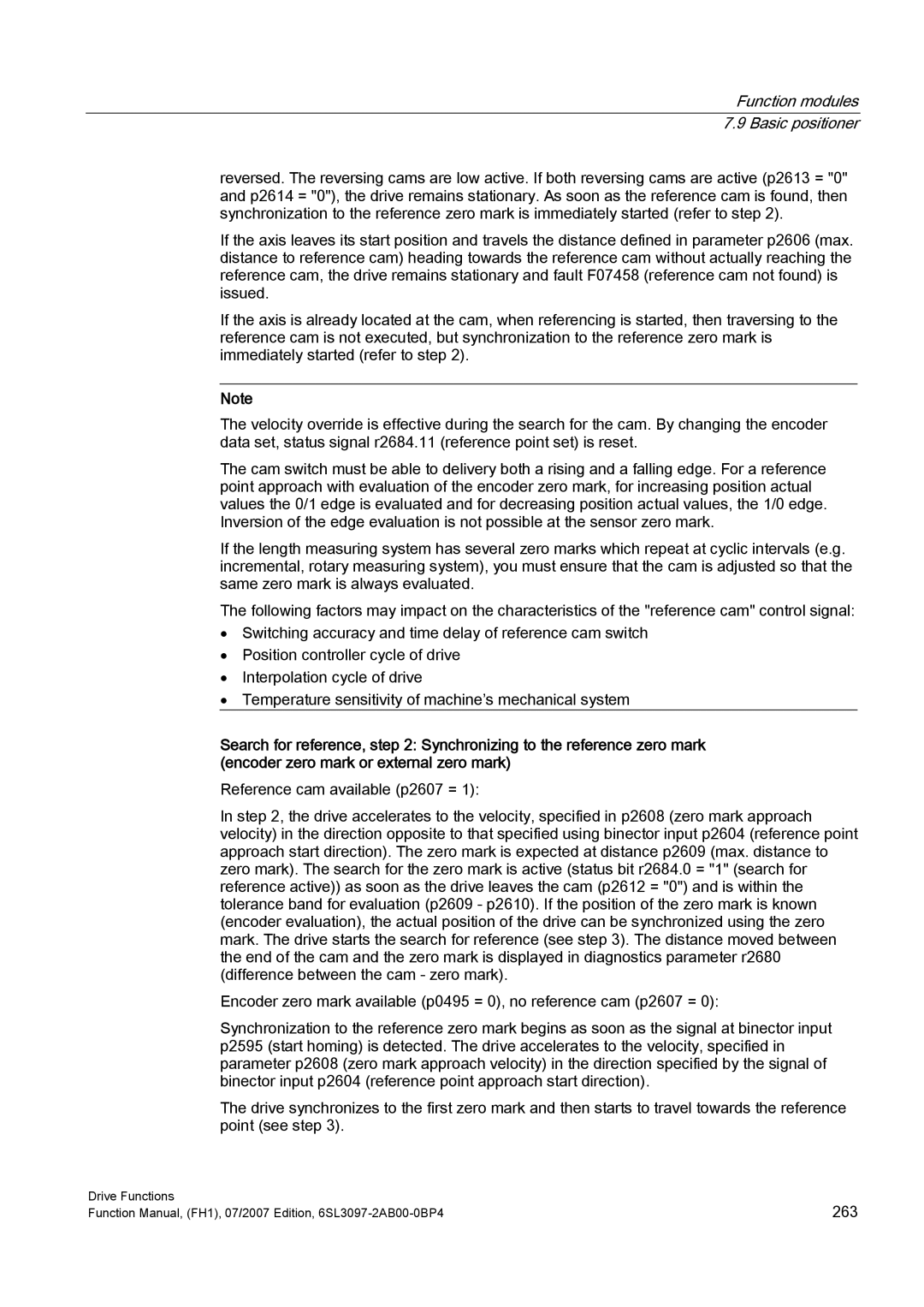
Function modules 7.9 Basic positioner
reversed. The reversing cams are low active. If both reversing cams are active (p2613 = "0" and p2614 = "0"), the drive remains stationary. As soon as the reference cam is found, then synchronization to the reference zero mark is immediately started (refer to step 2).
If the axis leaves its start position and travels the distance defined in parameter p2606 (max. distance to reference cam) heading towards the reference cam without actually reaching the reference cam, the drive remains stationary and fault F07458 (reference cam not found) is issued.
If the axis is already located at the cam, when referencing is started, then traversing to the reference cam is not executed, but synchronization to the reference zero mark is immediately started (refer to step 2).
Note
The velocity override is effective during the search for the cam. By changing the encoder data set, status signal r2684.11 (reference point set) is reset.
The cam switch must be able to delivery both a rising and a falling edge. For a reference point approach with evaluation of the encoder zero mark, for increasing position actual values the 0/1 edge is evaluated and for decreasing position actual values, the 1/0 edge. Inversion of the edge evaluation is not possible at the sensor zero mark.
If the length measuring system has several zero marks which repeat at cyclic intervals (e.g. incremental, rotary measuring system), you must ensure that the cam is adjusted so that the same zero mark is always evaluated.
The following factors may impact on the characteristics of the "reference cam" control signal:
•Switching accuracy and time delay of reference cam switch
•Position controller cycle of drive
•Interpolation cycle of drive
•Temperature sensitivity of machine’s mechanical system
Search for reference, step 2: Synchronizing to the reference zero mark (encoder zero mark or external zero mark)
Reference cam available (p2607 = 1):
In step 2, the drive accelerates to the velocity, specified in p2608 (zero mark approach velocity) in the direction opposite to that specified using binector input p2604 (reference point approach start direction). The zero mark is expected at distance p2609 (max. distance to zero mark). The search for the zero mark is active (status bit r2684.0 = "1" (search for reference active)) as soon as the drive leaves the cam (p2612 = "0") and is within the tolerance band for evaluation (p2609 - p2610). If the position of the zero mark is known (encoder evaluation), the actual position of the drive can be synchronized using the zero mark. The drive starts the search for reference (see step 3). The distance moved between the end of the cam and the zero mark is displayed in diagnostics parameter r2680 (difference between the cam - zero mark).
Encoder zero mark available (p0495 = 0), no reference cam (p2607 = 0):
Synchronization to the reference zero mark begins as soon as the signal at binector input p2595 (start homing) is detected. The drive accelerates to the velocity, specified in parameter p2608 (zero mark approach velocity) in the direction specified by the signal of binector input p2604 (reference point approach start direction).
The drive synchronizes to the first zero mark and then starts to travel towards the reference point (see step 3).
Drive Functions | 263 |
Function Manual, (FH1), 07/2007 Edition, |
